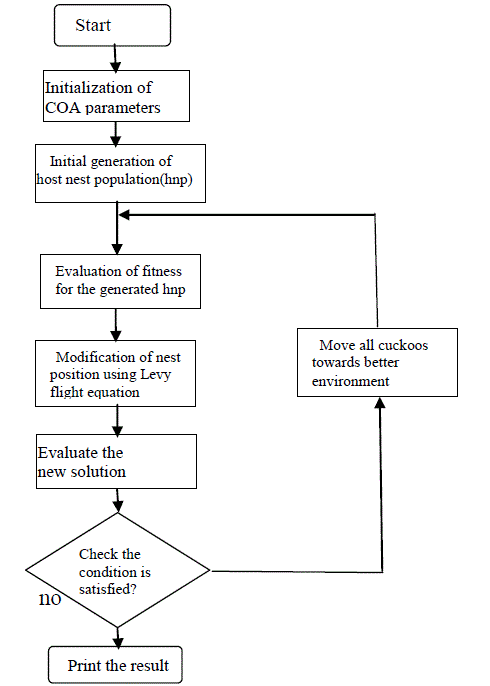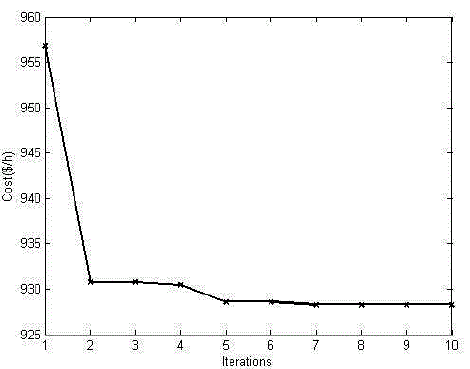This paper presents an efficient and reliable evolutionary-based approach to obtain optimal power flow (OPF) problem solution. The approach employs a nature inspired meta heuristic optimization algorithm called cuckoo optimization algorithm (COA) to determine the optimal settings of control variables. The performance of the COA is examined and tested on IEEE 14 bus test system with fuel cost minimization as objective function. The results demonstrate the potential of the COA shows its effectiveness and robustness to solve the OPF problem.
Keywords |
| Cuckoo optimization algorithm, optimal power flow, optimization techniques, cost minimization, power
systems. |
I.INTRODUCTION |
| Optimal power flow (OPF) has become one of the most important problem and it is the fundamental tool that enables
electric utilities to specify economic operating and secure states in power systems. The main objective of the OPF
problem is to optimize a chosen objective function such as fuel cost, piecewise quadratic cost function, fuel cost with
valve point effects, voltage profile improvement, voltage stability enhancement, through optimal adjustments of power
systems control variables while at the same time satisfying system operating conditions with power flow equations and
inequality constraints. The equality constraints are the nodal power balance equations, while the inequality constraints
are the limits of all control or state variables. The control variables involves the tap ratios of transformers, the generator
real power, the generator bus voltages and reactive power of sources. In general the OPF problem is a large-scale,
highly constrained, nonlinear and non-convex optimization problem. |
| The OPF problem has been solved by using traditional and evolutionary based algorithms. In the past conventional
methods were employed for the solution of OPF problem. H.W.Dommel and W.F.Tinney[1] firstly presented the
solution of optimal power flow. Conventional optimization techniques such as interior point method, linear
programming and nonlinear programming have been discussed by K.Deb [2]. However the disadvantage of these
techniques is that it is not possible to use these techniques in practical systems because of nonlinear characteristics such
as valve point effects, prohibited operating zones and piecewise quadratic cost function. Therefore it becomes
necessary to improve the optimization methods that are capable of overcoming these disadvantages and handling such
difficulties. Recently many population based optimization techniques have been used to solve complex constrained
optimization problems. These techniques have been increasingly applied for solving power system optimization
problems such as economic dispatch, optimal reactive power flow and OPF for decades. |
| Some of the population-based methods have been proposed for solving the OPF problem successfully such as genetic
algorithm(GA), particle swarm optimization(PSO), differential evolution(DE), simulated annealing(SA), Intelligent
search evolutionary algorithm(ISEA) etc., Then the topic has been handled by many researchers. R.Gnanadass et al. [3]
is devoted an evolutionary programming algorithm to solve the optimal power flow problem with non-smooth fuel cost
functions. M.R.AlRashidi and M.E.EI.Hawary [4] has reported a hybrid particle swarm optimization algorithm as a
modern optimization tool to solve the discrete optimal power flow problem with valve loading effect. M.Varadarajan
and K.S Swarup [5] presented differential evolution approach to solve optimal power flow problem with multiple
objectives. A.V.NareshBabu and S.Sivanagaraju [6] proposed a new approach based on two step initialization to solve
the OPF problem. Different methods to find the solution for OPF problem has been discussed in [7-9].
One of the recently proposed meta heuristic algorithm is the cuckoo optimization algorithm was proposed in [10-12]. It
is based on the intelligent breeding behaviour of cuckoo. In this paper, COA is used to solve the OPF problem which is formulated as a nonlinear optimization problem with equality and inequality constraints in a power system. The
objective function is to minimize the fuel cost. The performance of the proposed approach is sought and tested on the
standard IEEE 14 bus test system. Obtained simulation results demonstrate that the COA provides very remarkable
results for solving the OPF problem. |
II.MATHEMATICAL PROBLEM FORMULATION OF OPF |
| The OPF is a nonlinear optimization problem. The essential goal of the OPF is to obtain the optimal settings of control
variables in terms of a certain objective function subjected to various equality and inequality constraints. In general, the
OPF problem can be mathematically formulated as follows: |
| Min f(x,u) (1)
Subject to g(x,u) = 0 |
| h(x,u) ≤ 0 |
| Where f is the objective function to be minimized, x and u are vectors of dependent and control variables
respectively. x is the vector of dependent variables including: |
| Generator active power input at slack bus Pg1 |
| Load bus voltage Vl. |
| Generator reactive power input Qg. |
| x can be represented as: |
 (2) (2) |
| wherenpvandnpq defines the number of voltage controlled buses and number of PQ buses respectively.
In a similar way the vector of control variables u can be expressed as: |
 (3) (3) |
| Pg defines the active power output of generators at PV bus. |
| Vg depicts the terminal voltages at generation bus bars. |
| Qc represents the output of shunt VAR compensators |
| T stands for the tap setting of the tap regulating transformers. |
| wherent and nc define the number of tap regulating transformers and number of shunt VAR compensators, respectively |
| A.Objective function |
| The minimization of fuel cost is considered as an objective function to examine the performance of COA. The
aim of the fuel cost minimization is to determine optimal generation settings of thermal generating units which
minimize the total fuel cost while satisfying all the equality and inequality constraints. The total fuel cost function (J)
for a number of thermal generating units can be represented by a quadratic function as |
 (4) (4) |
| Where ai, bi& ci are cost coefficients of ith generator. |
| Pgi is the generation at ith generator |
| ng is the number of generator buses. |
III.CUCKOO OPTIMIZATION ALGORITHM |
| A. Overview |
| The cuckoo optimization algorithm (COA) is a nature inspired meta heuristic algorithm which is inspired by the life of
a bird family, called Cuckoo. Special lifestyle of these birds and their characteristics in egg laying and breeding has
been the basic motivation for development of this new evolutionary optimization algorithm. It is a novel evolutionary
algorithm, suitable for continuous nonlinear optimization problem. |
| Similar to other evolutionary methods, COA also starts with an initial population. The effort to survive among cuckoos
constitutes the basis of cuckoo optimization algorithm. During the survival competition some of the cuckoos or their
eggs may demise. The survived cuckoo societies immigrate to a better environment and start reproducing and laying
eggs. Cuckoos survival effort hopefully converges to a state that there is only one cuckoo society, all with the best
profit values. Application of the COA algorithm to some benchmark functions and a real problem has proven its
capability in solving complex, nonlinear and non-convex optimization problems. |
| The key features of the COA are faster convergence rate and reduction in computational complexity. Similar to other
evolutionary algorithms, it is also a population based algorithm. The initial population is randomly generated within the
control parameter limits. Then the levy flight operator is performed on all individuals until a stopping criterion is
reached. |
| B. Solution methodology of COA |
| The main steps of COA are shown in Fig.1 |
IV.NUMERICAL RESULTS |
| In order to demonstrate the effectiveness and robustness of the COA method to solve the OPF problem, the
objective function of fuel cost minimization is applied on IEEE 14 bus system [13] and the results are presented. The
method is implemented using MATLAB software on a personal computer with Intel Pentium dual core 2.6 GHz
processor and 1 GB RAM. The input parameters of COA for the test system are considered as the number of host nests
as 10, Levy flight constants λ as 1≤λ≤3 and α as rand (-1,1). The number of iterations to be 10. Table I summarizes the
OPF results. The real power generation and losses are expressed in MW and the cost is in $/h. The bus voltages and
corresponding phase angles for fuel cost minimization are given in Table II. |
| From Table I, it can be observed that the power generation of individual generators, generator voltage, total power
generation, total losses and the cost obtained using COA is satisfactory. Table II gives the voltage magnitudes and
corresponding phase angles at each bus using COA are better. Fig. 2 indicates the convergence characteristics of the
test system using COA. From Fig. 2, it can be observed that the initial cost (at 1st iteration) is 956.881 $/h and it falls to
928.285 $/h ( at 10th iteration) for COA.From this, it can be concluded that the initial cost and change in cost (from
1stiteration to 10th iteration) using COA is less and the fuel cost is minimized in less number of iterations.From this, it is
clear that COA gives the converged solution with less number of iterations and it results in reduction of computation
time. |
V. CONCLUSION |
| In this paper, one of the recently proposed heuristic algorithm COA is used to solve the optimal power flow problem in
powersystems. The OPF problem is formulated as a nonlinear optimization problem with equality and inequality
constraints in power systems.In this case theminimization of fuel cost is considered as objective function. This
approach was successfully and influentially performedto find the optimal settings of the control variables of test
system.The simulation results proved the robustness and superiority of the COA approach to solve the OPF problem.
The effectiveness of this algorithm is demonstrated on IEEE 14 bus system. The observations reveals that the COA
gives optimal solution with lessnumber of generations and requires less computation time. |
Tables at a glance |
 |
 |
| Table 1 |
Table 2 |
|
| |
Figures at a glance |
 |
 |
| Figure 1 |
Figure 2 |
|
| |
References |
- H.W.Dommel and W.F.Tinney, “Optimal power flow solutions,” IEEE Transactions on power apparatus and systems, Vol.PAS-87, pp.1866- 1876, Oct.1968.
- K.Deb, “Optimization for engineering design: algorithms and examples,” PHI, May.2009.
- R.Gnanadass, P.Venkatesh and Narayana Prasad Padhy, “Evolutionary programming based optimal power flow for units with non-smooth fuel cost functions,” Electric Power Components and Systems, Vol.33, pp.349-361, 2005.
- M.R.AI-Rashidi and M.E.EI-Hawary, “Hybrid particle swarm optimization approach for solving the discrete OPF problem considering the valve loading effects,” IEEE Trans. Power Syst.,Vol.22, No.4, Nov.2007.
- M.Varadarajan and K.S.Swarup, “Solving Multi-objective optimal power flow using differential evolution,” IETgener. Transm.Distrib.,Vol.2, No.5, pp.720-730, 2008.
- A.V.NareshBabu and S.Sivanagaraju, “A solution to the optimal power flow problem: A new approach based on two step initialization,” Proc. of IEEEIndia International Conference (INDICON) on Engineering Sustainable Solutions, BITS, Hyderabad, India, Dec. 2011.
- Abido MA. “Optimal power flow using particle swarm optimization,” Electr Power Energy Syst, Vol.24, pp.563–71, 2002.
- Abou El Ela AA, Abido MA, Spea SR. “Optimal power flow using differential evolution algorithm,” Electr Power Syst Res, Vol.80, pp.878– 85,2010.
- Abido MA. “Optimal power flow using tabu search algorithm,” Electr Power Compo Syst, Vol.30(5), pp.469–83,2002.
- X.S. Yang, S. Deb, “Cuckoo search via Lévy flights,” Proc. of World Congress on Nature & Biologically Inspired Computing, NaBIC, IEEE Publications, USA,pp.210–214, 2009.
- X.S. Yang, S. Deb, “Engineering optimization by Cuckoo search,” Int. J. Math. Modell. Numer. Opt. 1,pp.330–343,2010.
- RaminRajabioun, “Cuckoo Optimization Algorithm,” Applied Soft Computing, Vol.11, Issue 8, pp.5508-5518, Dec 2011.
- IEEE 14-bus system data available at http://www.ee.washington.edu/research/pstca
|